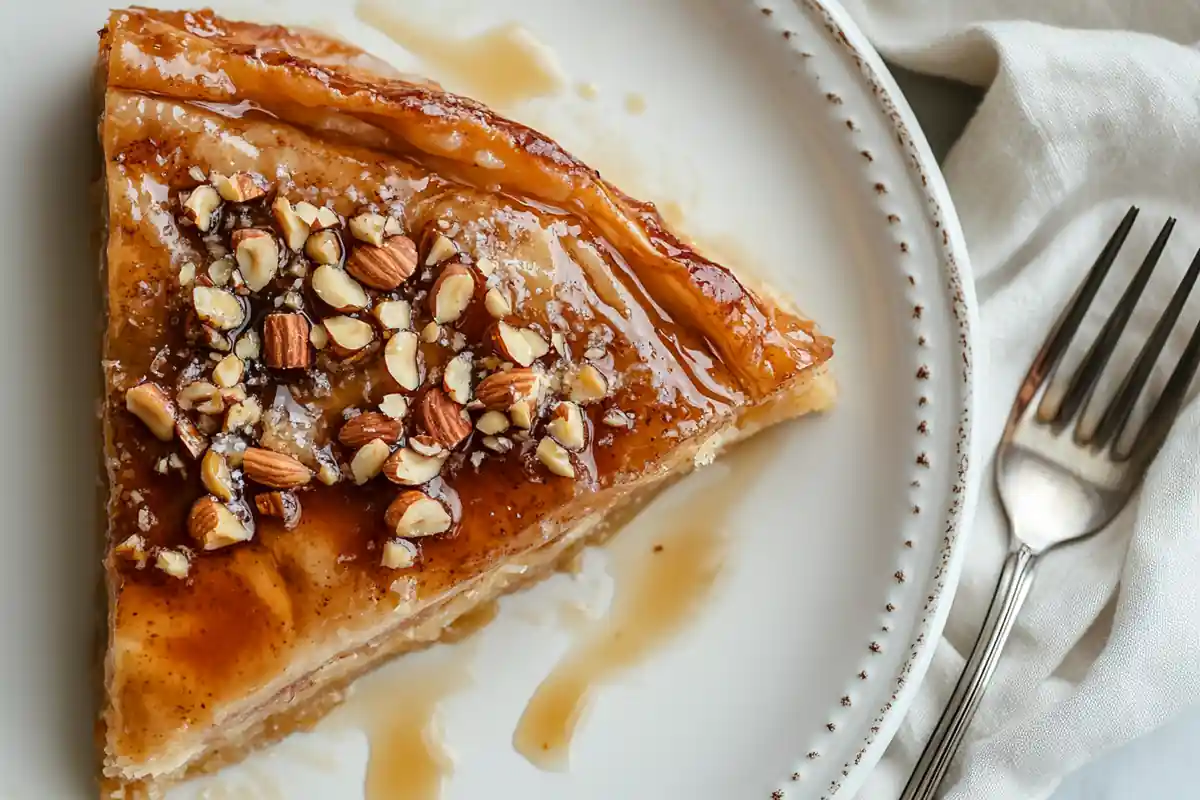Estimated reading time: 12 minutes
This easy baklava recipe offers a simplified method to make this classic sweet treat. It focuses on easy steps and readily available ingredients, perfect for beginners. Enjoy a delicious homemade baklava with ease.
Table of contents
The Secret to a Simple Yet Delicious Baklava
Making baklava at home might seem tricky, however, this easy baklava recipe is designed for success. You will get that sweet, flaky pastry with minimal effort. This guide simplifies traditional methods, ensuring a delicious result every time. Consequently, you will have a satisfying dessert that will impress everyone. Specifically, we focus on easy-to-follow steps and common pantry items. Therefore, even novice bakers can enjoy homemade baklava. Indeed, this is a wonderful way to enjoy an indulgent dessert without spending hours in the kitchen.
Easy Baklava Recipe: Your Step-by-Step Guide
Indeed, this recipe breaks down the baklava making process. First, we’ll gather the necessary ingredients. Next, we will assemble the layers. Finally, baking and syrupping create the perfect baklava. Altogether, this process will lead to a rich and delicious dessert. Undoubtedly, this is a dessert worth making. Chiefly, focus on each step for optimal results. Specifically, the process is designed to be both simple and rewarding. Moreover, it will surely be a crowd-pleaser.
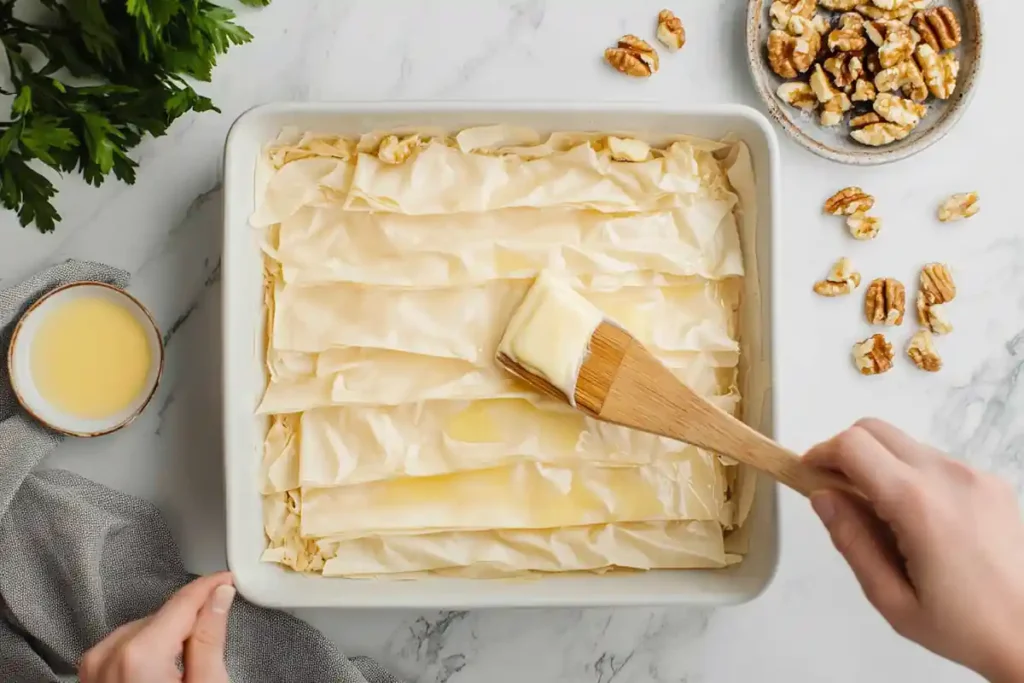
Ingredients for Your Easy Baklava
- 1 pound phyllo dough, thawed
- 1 cup (2 sticks) unsalted butter, melted
- 1 1/2 cups mixed nuts (walnuts, pistachios, almonds), finely chopped
- 1 teaspoon ground cinnamon
- 1/2 teaspoon ground cloves
- For the Syrup:
- 1 1/2 cups granulated sugar
- 1 cup water
- 1/2 cup honey
- 1 tablespoon lemon juice
- 1 teaspoon orange blossom water (optional)
Ingredient Notes for Baklava
- Phyllo Dough: Freshness is key. If using frozen, thaw completely. Patches of humidity might appear; don’t worry about them. If the dough is dry, you can add a damp towel on top while assembling the baklava. Accordingly, working with slightly damp dough will be more manageable.
- Nuts: Use any combination you enjoy. Additionally, you can toast them lightly for added flavor. Accordingly, using chopped nuts is essential to ensure an even distribution within the baklava. Furthermore, remember to not overchop them. Moreover, finely chopped nuts provide a delicate texture.
- Spices: Adjust cinnamon and cloves to your liking. Moreover, you can add a pinch of cardamom. Afterward, your baklava will have a more nuanced flavor. Furthermore, consider adding a touch of nutmeg for extra warmth.
- Butter: Unsalted butter allows better control over the final flavor. However, you can use salted butter, just reduce the salt added later. Indeed, melted butter is what gives the phyllo those beautiful layers.
- Syrup: Honey is essential for a truly authentic taste. Nevertheless, if it is unavailable you can use maple syrup as a substitute. Therefore, make sure to adjust the amount to your preference. The orange blossom water is optional but it adds an elevated touch. However, if you don’t have it, you can omit it.
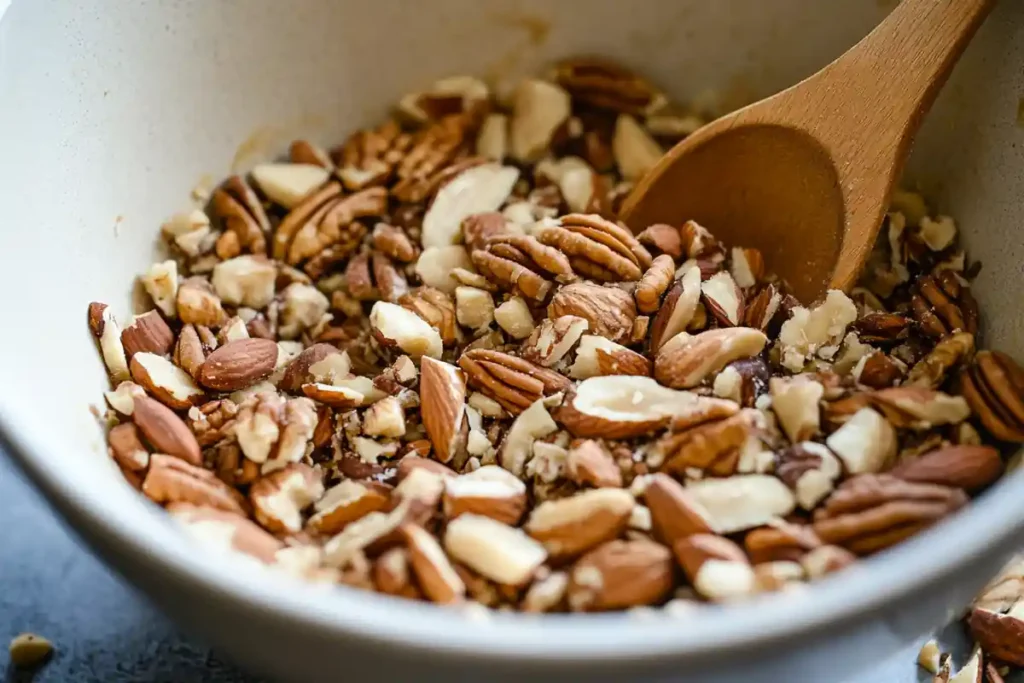
Preparing Your Easy Baklava
- Preheat the oven to 350°F (175°C).
- First, brush a 9×13 inch baking pan with melted butter.
- Next, gently lay one sheet of phyllo dough in the pan. Brush lightly with melted butter.
- Repeat this process with 6-8 more phyllo sheets, brushing each with butter. Ensure each layer is covered well.
- Subsequently, combine the chopped nuts, cinnamon, and cloves in a bowl. Mix well. Make sure the spices are evenly distributed.
- Afterward, sprinkle half of the nut mixture evenly over the phyllo layers. Cover the entire surface.
- Then, layer 6-8 more phyllo sheets, brushing each with butter as before. Take your time while doing this to keep everything tidy.
- Following this, sprinkle the remaining nut mixture over the phyllo. Distribute it uniformly.
- Finally, top with 6-8 more phyllo sheets, brushing each with butter. Make sure to smooth out any wrinkles.
- Use a sharp knife to score the baklava into diamond or square shapes. Make sure to cut through all the layers. However, don’t cut all the way to the bottom of the pan.
- Then, drizzle the remaining melted butter evenly over the top. Ensure every inch is covered.
- Bake in the preheated oven for 30-35 minutes. The baklava should be golden brown. Watch carefully so that it doesn’t burn.
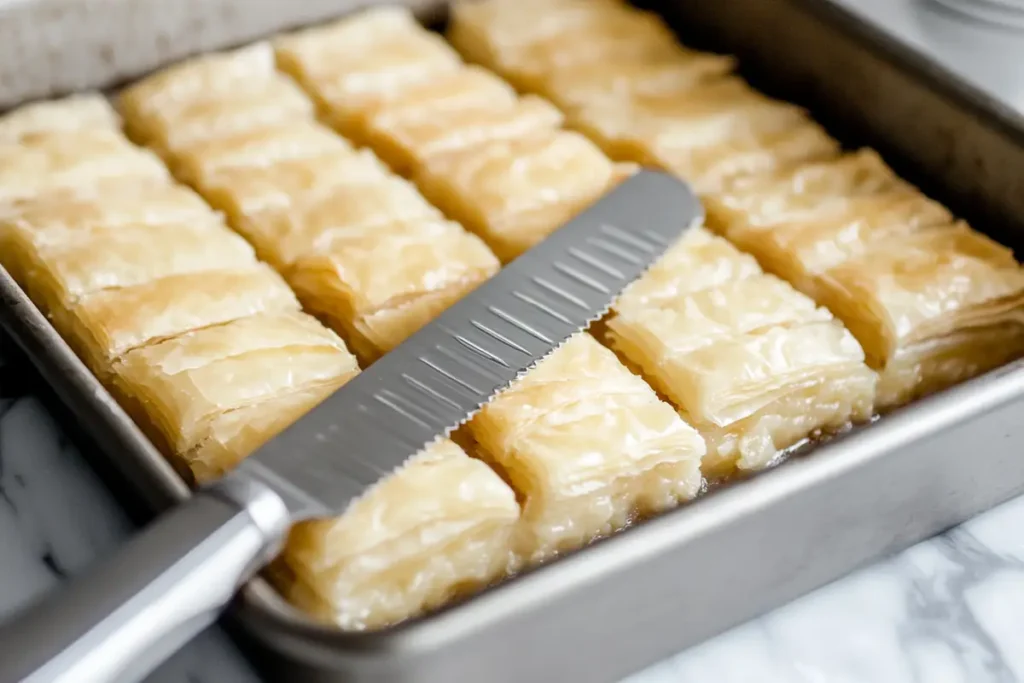
Making the Syrup for Your Easy Baklava Recipe
- While the baklava bakes, prepare the syrup. This allows the syrup to cool down a bit.
- In a saucepan, combine sugar, water, and honey. Use a medium-sized saucepan.
- Add the lemon juice. The lemon will help balance the sweetness.
- Bring to a boil, then reduce heat and simmer for 15 minutes. Keep an eye to ensure it doesn’t stick.
- Subsequently, remove from heat and stir in the orange blossom water. This will add a beautiful aroma.
- Let the syrup cool slightly. It needs to be warm, not piping hot.
Syrupping and Finishing Your Easy Baklava
- Once the baklava is golden brown, remove it from the oven. Use oven mitts to protect yourself.
- Immediately pour the warm syrup slowly and evenly over the hot baklava. Pour slowly to allow it to seep through.
- Allow the baklava to cool completely and absorb the syrup (about 4 hours). Generally, the longer it sits, the better it will taste. Indeed, this patience will be rewarded.
- Finally, serve and enjoy your delicious homemade easy baklava. It’s a treat worth waiting for.
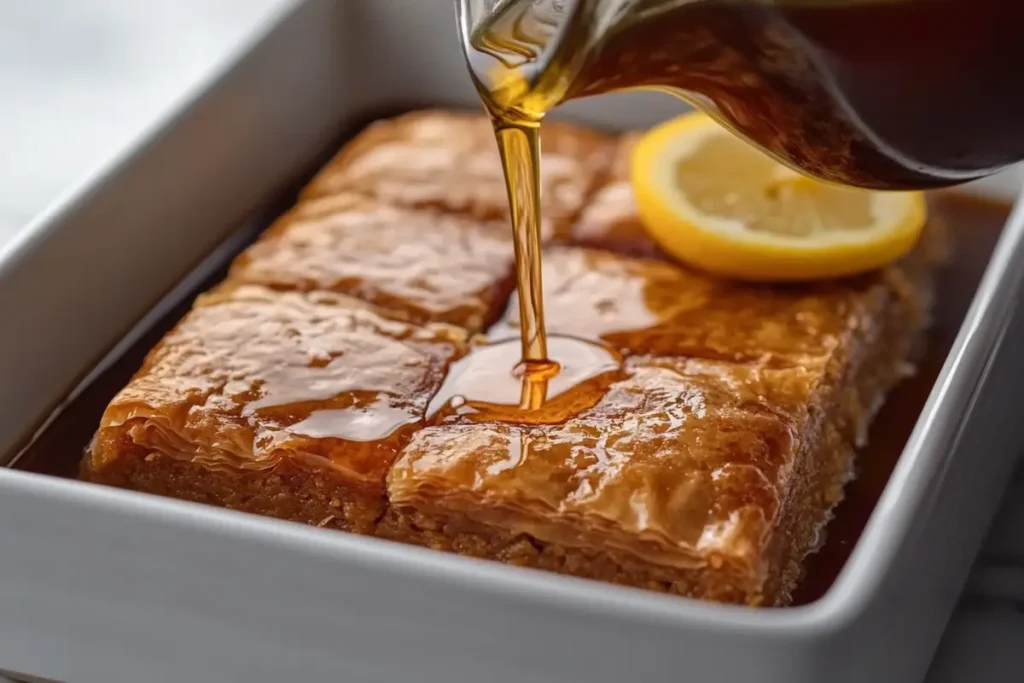
Essential Cooking Tips for Easy Baklava Success
- Phyllo Handling: Keep the phyllo dough covered with a damp towel to prevent it from drying out. Work quickly to avoid tearing. Indeed, it dries out very fast so keep it covered.
- Butter Usage: Brush each layer evenly with butter. This ensures a flaky and rich texture. Therefore, do not skimp on the butter.
- Scoring the Baklava: Use a very sharp knife for scoring to ensure clean cuts. Score the baklava before baking. This will help the syrup reach all the layers. However, don’t cut all the way down.
- Syrup Temperature: The warm syrup needs to be poured over the hot baklava. This creates a wonderful balance. Specifically, the heat contrast is very important.
- Cooling Time: Allow adequate cooling time. The baklava needs time to absorb the syrup properly. This is key for a moist result. Therefore, be patient! Undoubtedly, the wait will be worth it.
- Storage: Store any leftover baklava in an airtight container at room temperature for up to a week. You can also store it in the fridge, however, it might become harder. Additionally, be sure to keep it covered.
Exploring Variations of this Easy Baklava Recipe
- Nut Variations: While the classic baklava includes walnuts, pistachios, and almonds, feel free to experiment. For example, you can use pecans, cashews, or even macadamia nuts. Specifically, using a single type of nut or a unique mix can elevate the final taste. Likewise, toasted nuts add a deeper flavor profile. Furthermore, consider adding seeds for extra texture.
- Spice Variations: Additionally, vary the spices to create different flavor combinations. For example, add a pinch of cardamom, nutmeg, or even a hint of ginger. Moreover, experiment with citrus zest, such as lemon or orange, to brighten the flavors. Indeed, these small additions can make a big difference.
- Syrup Variations: Furthermore, the syrup can be adjusted to suit your taste. For example, you could use a combination of honey and maple syrup. Alternatively, you can infuse the syrup with other flavors. Consider a vanilla bean or a cinnamon stick while simmering. Additionally, a touch of rose water provides a floral twist, if you don’t have orange blossom water.
- Chocolate Baklava: For a different take, incorporate some chocolate. For instance, sprinkle mini chocolate chips or a thin layer of melted chocolate over the nut mixture. Moreover, a drizzle of melted chocolate over the finished baklava can create a truly indulgent dessert.
- Vegan Baklava: Additionally, you can adapt this recipe for a vegan version. Simply, substitute the butter with a good quality plant-based butter. Additionally, you can use agave nectar or maple syrup instead of honey. Therefore, it can be enjoyed by everyone.
Serving Suggestions for Your Easy Baklava
- With Tea or Coffee: Traditionally, baklava is served with a cup of hot tea or coffee. Indeed, the warm beverage compliments the sweetness of the pastry. Specifically, Turkish coffee or black tea are great options. Moreover, the bitterness of the coffee balances out the sweetness of baklava.
- With Ice Cream or Yogurt: Conversely, pair it with a scoop of vanilla ice cream or Greek yogurt for a refreshing contrast. Specifically, the cold, creamy textures provide a wonderful balance to the rich and flaky baklava. Moreover, a dollop of plain yogurt can offer a lovely tanginess.
- Garnishes: Additionally, you can garnish the baklava for added visual appeal. For example, sprinkle extra chopped nuts or a dusting of ground cinnamon. Moreover, add a sprig of mint for freshness. Furthermore, a drizzle of honey adds a touch of elegance.
- Special Occasions: Indeed, baklava is often served during special occasions and celebrations. Specifically, it’s a beautiful addition to any dessert table. Furthermore, it is the perfect dessert to share with loved ones.
The Art of Phyllo Dough Handling: A Deeper Dive
- Thawing: If you are using frozen phyllo dough, be sure to thaw it correctly. Therefore, allow it to thaw overnight in the refrigerator. Avoid thawing it at room temperature. Moreover, this will cause it to become sticky.
- Preparation: Before you start, clear a space on your counter. Then, unroll the phyllo dough. Then, cover it with a lightly damp towel. Indeed, this will stop it from drying out while working with it.
- Separating the Sheets: Carefully separate each sheet of phyllo dough. Therefore, handle them gently. Avoid tearing or crumpling them. Furthermore, if they stick, be very delicate.
- Brushing: Ensure you coat each layer evenly with melted butter. This is key for that perfect texture. Also, make sure to get all the edges as well.
- Patience: Be patient, the dough can be a bit tricky to work with. However, it will be easier as you get comfortable.
Understanding the Importance of Syrup
- Syrup Consistency: The syrup should have a medium consistency. Therefore, it needs to coat the baklava without making it soggy. Also, the simmering process is vital.
- Temperature Matters: Specifically, the contrast between the hot baklava and the warm syrup is essential. Consequently, this creates the perfect texture.
- Infusing Flavors: Furthermore, you can infuse different flavors into the syrup. For instance, add lemon zest, orange slices, or star anise while simmering.
- Sweetness Level: Adjust the amount of sugar and honey to achieve your preferred level of sweetness. Indeed, this is all about personal preference.
Easy Baklava and Cultural Significance
Baklava isn’t just a dessert; it carries rich cultural and historical significance. It has roots in the Middle East and has become popular across the Mediterranean and beyond. Indeed, it’s often associated with celebrations and important gatherings, and is a dessert that’s shared between generations. Therefore, making and sharing baklava is a way to connect to history and tradition. Additionally, it makes every meal just a bit more special.
The Nutritional Benefits of Easy Baklava Recipe
| Nutrient | Amount per serving (approximate) | Notes |
| Calories | 350-400 | Varies depending on serving size and specific ingredients used. |
| Total Fat | 20-25g | Mostly from butter and nuts. |
| Saturated Fat | 10-15g | Primarily from butter. |
| Cholesterol | 50-70mg | Present in butter. |
| Sodium | 50-100mg | Naturally occurring, can be increased with salted butter or the addition of salt. |
| Total Carbohydrate | 40-50g | Mostly from sugar, honey, and phyllo dough. |
| Dietary Fiber | 2-4g | From nuts. |
| Sugars | 30-40g | Primarily from sugar and honey. |
| Protein | 5-7g | From nuts. |
| Vitamin E | Variable | Found in nuts and butter. |
| Manganese | Variable | Present in nuts. |
| Copper | Variable | Present in nuts and other ingredients. |
| Phosphorus | Variable | Found in nuts and dairy ingredients. |
Conclusion
This easy baklava recipe simplifies a classic dessert, making it accessible to everyone. Specifically, by following these steps and tips, you can create a delicious, homemade baklava. Therefore, it is the perfect dessert for any occasion. Furthermore, enjoy the rich flavors of this sweet pastry and impress your loved ones with your culinary skills. Indeed, it’s a treat that’s sure to bring joy to everyone. Unquestionably, making this easy baklava will become a delightful habit.
Frequently Asked Questions (FAQs)
What is real baklava made of?
Real baklava is typically made of thin layers of phyllo dough, chopped nuts (such as walnuts, pistachios, or almonds), and a sweet syrup. Moreover, butter is used to brush between the layers, creating a flaky texture. Specifically, the syrup is usually a mixture of sugar, water, honey, and lemon juice. Furthermore, some variations may include orange blossom or rose water.
What is the difference between Greek baklava and Turkish baklava?
While both are delicious, there are subtle differences between Greek and Turkish baklava. Basically, Greek baklava often uses walnuts and honey as key ingredients, with a simple syrup. Comparatively, Turkish baklava frequently features pistachios and a more complex syrup, sometimes with rose or lemon flavorings. Another difference lies in the cutting: Greek baklava is often cut into triangles, while Turkish baklava may be cut into squares or diamonds.
What is the secret to crispy baklava?
Indeed, the key to crispy baklava is all about technique and temperature control. Firstly, make sure the phyllo dough is fresh and handled properly. Secondly, use enough melted butter to coat every layer evenly. Thirdly, ensure that the oven temperature is correct for thorough cooking. Finally, the syrup should be poured over the baklava right after it comes out of the oven, while it’s still hot. Ultimately, this process ensures that the syrup is absorbed properly while maintaining crispness.
Do you put hot or cold syrup on baklava?
Specifically, for the best results, always pour warm or hot syrup over hot baklava. Therefore, the temperature contrast is crucial. Undoubtedly, the hot baklava absorbs the warm syrup more effectively, leading to a perfectly moist yet crispy dessert. Otherwise, cold syrup may result in a soggy baklava.

